Where does content marketing belong in the organization and do you need someone to manage it? A high-level overview of tasks and challenges.
Depending on the scope, context and ‘content marketing maturity level’ of your organization, you will organize the way you “do” content marketing differently. There will always – at the very least – be some people (internal, external or hybrid) who create content, someone who overviews the “project” (which in the end it is) and involvement of several stakeholders.
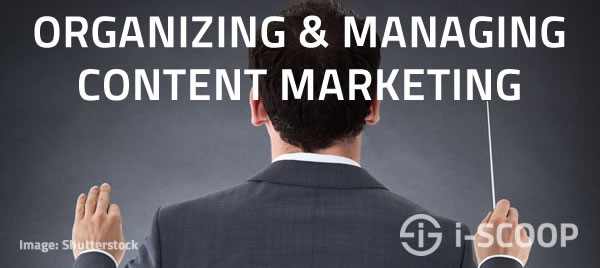
As your content marketing maturity grows, opportunities become clearer and results of early initiatives or even pilot projects show positive impact, organizing and structuring will probably get more attention as well. In this article we set the scene of planning and managing content marketing from a human, organizational and collaborative perspective, before diving deeper into actionable tips and advice.
When thinking about how to plan the content program from a practical resources viewpoint, never copy a pure “publisher model” just like that. You don’t need to be a publisher, you need to be a customer experience and value creation expert. It’s not about nifty job titles or nice models, it’s about roles and “who can/will do what today, tomorrow and next year” to make it – collaboratively – happen.
Ideally, all those structures, teams and processes are in place (or better: the framework is laid out) before starting with content marketing and after having done or during the strategic content marketing exercise, across different silos and involving multiple departments, the customers and target audiences. However, in practice businesses seldom go from low maturity to a full-blown integrated content marketing approach, unless there is strong buy-in to develop a content marketing program from management. We will cover those maturity levels (essentially about underlying processes and the essentials of a good content marketing plan) in a different article.
- Note 1: there is no blueprint that fits each organization but there certainly are different common parameters to have a project-oriented approach with a maturity-oriented roadmap approach .
- Note 2: having project and portfolio management (PPM) skills, certainly helps.
- Note 3: content can serve many goals and is essential in all forms of marketing. Furthermore, each business, goal and customer is different. Finally, there is always a legacy, also on a technology level (which is always present in content marketing).
Which department is responsible for content marketing?
This is a question that we often receive: who is responsible for content marketing? It is not the same as the question who owns content marketing in the business. The second question is easy to answer: no one owns content marketing as it touches all business functions and no department has all the skills nor the know-how to use content marketing in the many ways it can be used. Furthermore, ownership is not what we want to discuss in a customer-centric and optimization-driven content organization. This is a collaborative exercise and it starts with strategy, including knowing where content sits today across the organization in a ‘situation analysis’ (helping you to gauge maturity as well).
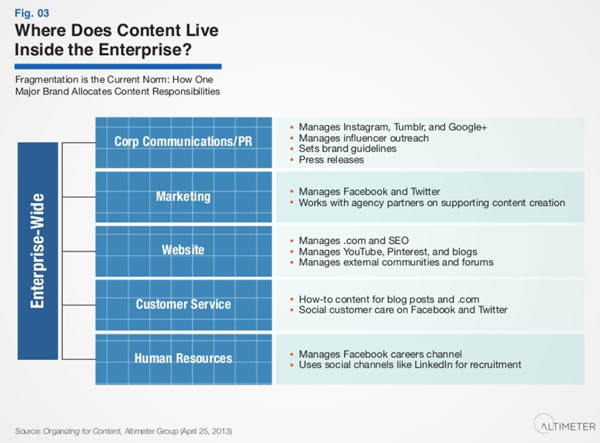
So, which department is responsible (from the who does what, when and where perspective, not ownership) for content marketing, social media marketing and other forms of what people still call “new ways of doing marketing”? Again: note that the question is about responsibility and management (who does what and where), not ownership?
The default answer to responsibility questions of course is: 1) it’s not a department questions (some organizations even have dedicated content marketing teams) and 2) “it depends”. And it always really depends on numerous factors. It’s difficult to compare a large international B2B technology company with long sales cycles and a complex go-to-market model, to a local fast moving consumer goods e-commerce pure player or a non-profit organization, for instance. So, let’s take a look at the responsibilities in content marketing.
The most interesting work regarding the organization of content marketing has been done, without any doubt, by Rebecca Lieb of Altimeter Group. Rebecca looked at all the organizational models being de facto used for content strategy and content marketing (not the same thing). You can check out the full report on SlideShare.
Why – to us – the most interesting work? Because – on top of being a heck of an effort – it fits with what we have seen and done in practice (note we mainly have been working for larger, international firms, so do look at your context). Especially the editorial board, Center of Excellence approach and the clear need for a content lead are very recognizable. But also other approaches are not unfamiliar. In fact, often we’ve seen a mix of several of the approaches as depicted below and explained in Rebecca’s great report.
Note: although we have seen the Content Center of Excellence approach, most often the Centers of Excellence (CoEs) we’ve been working with were not just for content but within, for instance a digital Center of Excellence. A CoE model is often used in transformational processes whereby collaboration across silos and with hybrid teams is needed. It’s been used in IT, BI and other areas for ages. We find it to be an approach that works well – when all stakeholders collaborate well, the core challenge – and it is known in many organizations, which makes it understandable for the C-level and other departments who get involved as they might have used it and thus can help you do it.
Depending on circumstances, it’s often good to have a Center of Excellence. That seems like an expensive term – and it is really – but it works very well, if there’s a “human”, cultural and collaborative match. Working with a Center of Excellence has been used in IT, business intelligence and digital marketing, to name just a few, forever. In fact, it’s used in transformational processes where there’s a need for horizontal, cross-silo, diagonal, vertical, in-house, outsourced and whatnot collaboration.
Do we need content marketing directors or chief content officers?
Some organizations have so-called Chief Content Officers. We see them more often than before but in specific circumstances. Take Ann Handley of MarketingProfs, for instance, whose business card mentions “Chief Content Officer” (CCO). MarketingProfs is an organization with a very content-intensive business model (where content is even at the core of the business), so it’s not the average organization. However, we also see the CCO function pop up mostly in companies with more complex business models, a strong international presence and/or strong focus on knowledge.
The question now is whether or not you need such a CCO or at least someone who is “responsible” for content (marketing)? The same question applies for the social media director or social media manager or whatever you call him: do you need one?
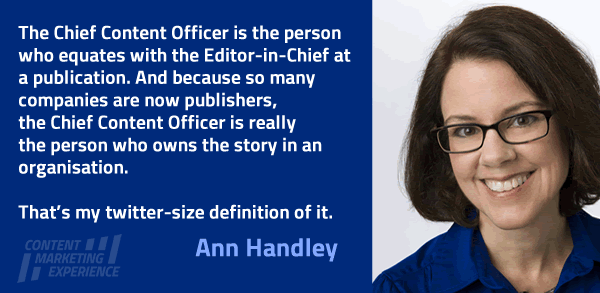
When it comes down to social, the answer is quite simple. Social media can play a role in every department of your company and in every “business function”, including the often forgotten ones such as customer service, HR or R&D. You have executing roles for people such as community managers or web care collaborators (often integrated in customer service) on one hand, and on the other hand, you regularly see managers – certainly in larger corporations – with a global social media management role. Do you need those?
The answer also depends on numerous factors, but if your business is professionally using social media, in several areas (not only PR or marketing, as is often the case), it might require someone that has a social media director role, regardless of the name of the function.
What about the Chief Content Officer? Nowadays, content – and more specifically what it triggers – plays such an important role (within the right context) that businesses pay a lot of attention to it. Content touches all channels (social, email, SEO,…) and all functions (sales, R&D, marcom, customer service, lead nurturing, PR, …). Furthermore, it’s key in evoking emotions, engaging people and storytelling, with word-of-mouth and also conversion as important leitmotivs.
However, the question remains: do you need a separate manager to oversee the content planning and marketing activities? In daily business practice, we have found that this is indeed often necessary.
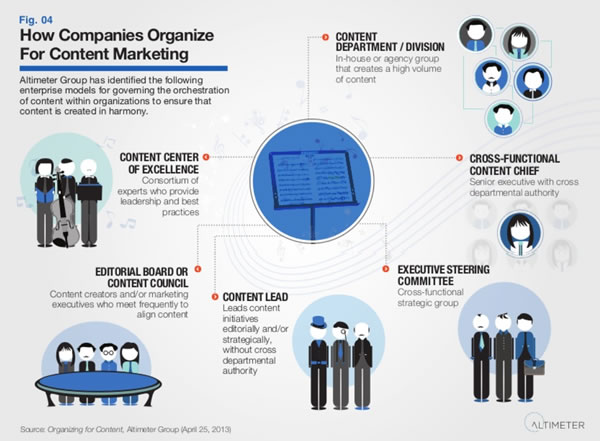
Why often someone should be responsible for content (marketing)
The managing role is mostly one of a “managing editor”, who can report to different people and has a role that combines project management and editorial functions. Having a full-fledge Chief Content Officer is something else and rather rarely a need or fact. On the other hand, given the huge role of content, it’s worth looking at if you can within your context. Ann Handley for instance favors a C-level title as you can read here (note: remember the US and the world – if you’re internationally active are big markets). Also check out the simple content marketing org chart she made below (and keep in mind the business of MarketingProfs) and an article she wrote about how to hire a Chief Content Officer.
Sometimes hiring a CCO can be an excuse/solution for a lack of collaboration. Most companies are stuck in silo-thinking, have fragmented divisions and lack company-wide cooperation and overview. When organizing our Content Marketing Conference Europe 2014, however, we noticed some people carried the title CCO as well.
Businesses have always massively produced content and they increasingly do so. However, they often don’t realize it or only use an insignificant percentage of what they “have”. A content marketing responsible is frequently necessary to inventorize available content, advice a holistic and intelligent use of it and pro-actively foresee it, while streamlining processes, building bridges, filling in gaps and having a cross-divisional supervisory role.
In practice the “responsible” – regardless of the name – is often a 360 degree and customer-centric thinking person, acting as a sort of human “glue” between various divisions, life cycle based customer needs and business priorities with a few goals/tasks such as:
- Providing the “internal” clients with what they require (sales, services, etc.): ensuring that there is material for every person that comes into contact with the customer or prospect. This includes simple collateral but also multimedia and interactive content that can be used for need detection and for life cycle based customer interactions.
- Providing the “external” clients (in the broadest sense) with better information, relevant contextual content, and ways to “generate” content themselves. Thus he assists in increasing customer satisfaction, customer loyalty, conversion marketing, up-selling, cross-selling, etc., but he also plays a role in conversations, word-of-mouth and storytelling.
- Overseeing the processes of creating, distributing and offering shareworthy and engaging content, integrating user-generated content, combining inbound techniques and for optimizing conversion processes, using various types of content depending on the context (persona’s, transactional behavior, peer recommendations, etc.) .
- Manage editorial processes and ideation processes, from an event-based approach to a needs-based approach (content gap analysis), which requires customer intelligence, and more.
What companies are still working through is unified tactical program planning and execution to guide and improve partner and internal team efforts. For example: with a content marketing program, content strategy, creative, search, social, email, media, local, and analytics all have to work together to be as effective as possible. However, what we typically find is that these groups are not structured to interact, making centralized planning beyond budgeting difficult to achieve. And, when speaking about cultural changes, teams must learn to unite around integrated efforts, identifying ways to assist related tactical executions to achieve common outcomes.
The content marketing centipede
A content marketing responsible has a direct impact on branding, community, collaboration, conversion and bottom-line.
Here are some more typical roles of a content marketing responsible, a real centipede (and thus often not one person):
- has frequent and systematic contact with all divisions (and customers in general) and knows about their needs.
- understands what SEO is, what conversion processes are, how social media marketing works and how inbound and outbound channels enhance eachother.
- knows how content travels on social networks and especially why it travels: he is people-centric and knows what influences behavior. It is therefore someone who can not easily be fitted in with existing divisions.
- hard to find and more often than not you will need several people to have all these skills. The marcom or PR team is usually not where he belongs but he needs to be in close touch with marcom, PR and several teams outside of marketing (customer service, product management, brand management, sales,…), with whom he also has to cooperate.
- must be involved at a very early stage in the development of new services or products, the organization of events, the establishment of lead management processes, etc. to avoid that the content comes at the end of the chain (even including R&D if present, where ideas are born and take shape).
- must also develop new initiatives, among other things in the area of content pillar development, content-intensive campaigns or interactions.
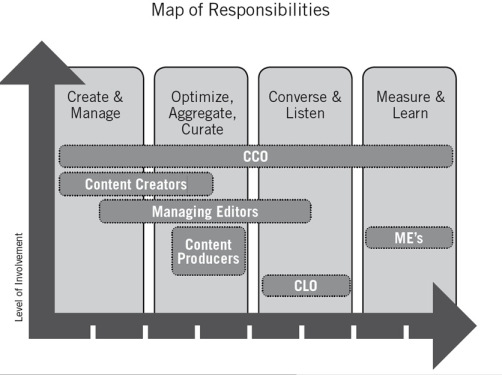
So, a new role then after all? In an organization where collaboration is poor and where management fails in streamlining the business objectives in a uniform (read: customer-centric) way, this is necessary on a management level, in others these more managerial tasks can be split. After all, are there many businesses today that are able to streamline everything in a data driven and a holistic way really? Is there someone in a company that has a single customer view, can inventorize, create, repurpose, curate and optimize all content related activities, depending on numerous objectives and needs at the same time?
Very few and that’s a pity really. Try the following exercise: just look at how many presentations your product managers, consultants and analysts have, how many white papers you have within your business or – if you are in an internationally active group – are available via “corp”? How much content and knowledge does your company possesses, without it actually being used optimally for your customers, prospects, social connections, all possible business objectives and internal and external needs?
The “content orchestrator”
A friend, AJ Huisman, an early adopter of the content marketing approach (check out the report of our 2010 content marketing round table, where AJ was present), and speaker at Content Marketing World and our Content Marketing Conference Europe 2014, expressed it like this when debating the topic: “If you have an organization that is clearly aware of what the customer needs and wants to hear, then you definitely don’t need a Chief Content Officer. However, I have rarely come across organizations where this customer focus comes naturally”. Isn’t that similar to the – need of – the rise of the Chief Customer Officer?
Everyone within an organization should really act a bit like a Chief Content Officer, since everyone should feel the natural urge to think like a customer and to understand what more can be offered to the same client or prospect, by combining and using all the relevant content flowing within, from and to the organization.
As AJ puts it: “Maybe it would be better if we call him a Contributing Content Orchestrator – someone that contributes to combine all content, as though he or she was a conductor, in a relevant and harmonious manner in real-time. In the end, we all have to contribute to that same purpose”. We liked that image (hence the stock image at the top of this article): music is made to enchant an audience and if you are a musician in an orchestra you’ll know about team work and the role of an orchestrator.
So, that purpose has a name: the customer experience, in the broadest possible sense of the word. The concert.
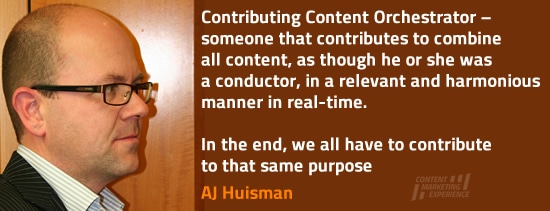
Just as in social media marketing, everything revolves around customer-centricity and therefore, per definition, coordinated collaboration. If that doesn’t happen, all required change management included, businesses miss out on various opportunities. And then it is almost impossible to identify and use all the information and content that you dispose of in a useful way for your customers, communities and therefore, in the end, your short-term AND long-term bottom-line.
A ‘social’ company is a customer-centric company. And what goes for social media, goes for content marketing as well. In fact, it goes for marketing and business in general.

